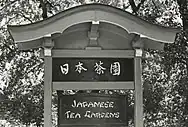A wonton font (also known as Chinese, chopstick, chop suey,[1] or kung-fu) is a mimicry typeface with a visual style intended to express an East Asian, or more specifically, Chinese aesthetic.
Styled to mimic the brush strokes used in Chinese characters, wonton fonts often convey a sense of Orientalism. In modern times, they are sometimes viewed as culturally insensitive or offensive.
History
The first commercial typeface of this style was patented in 1883 by the Cleveland Type Foundry,[1] under the name "Chinese",[2] which became "Mandarin" in the 1950s.[2] Many variations of this style of font have been created by typeface designers since its inception.[1]
Controversy
Some Asian-Americans find wonton fonts amusing or humorous, while others find them offensive, insulting, or racist.[3][4] The font's usage is often criticized when paired with caricatures that hark back to the Yellow Peril images of the late 19th and 20th century. In 2002, clothing retailer Abercrombie & Fitch faced controversy when it produced a series of T-shirts with buck-toothed images and wonton font slogans.[5] The Chicago Cubs experienced backlash from East Asian–Americans after a similarly offensive T-shirt was produced by an independent vendor in 2008.[6] The questionable use of such fonts was the subject of an article in the Wall Street Journal by cultural commentator Jeff Yang.[7]
References
- 1 2 3 Quito, Anne (April 8, 2021). "Karate, Wonton, Chow Fun: The end of 'chop suey' fonts". CNN Style. Archived from the original on April 11, 2023. Retrieved April 14, 2023.
- 1 2 NERD, new experimental research in design : positions and perspectives. Michael Erlhoff, Wolfgang Jonas, Board of International Research in Design. Basel, Switzerland. 2018. ISBN 978-3-0356-1742-9. OCLC 1076409412.
{{cite book}}: CS1 maint: location missing publisher (link) CS1 maint: others (link) - ↑ Shaw, Paul (June 17, 2009). "Stereo Types". Print Magazine. Retrieved October 5, 2019.
- ↑ Fernández, Nichole (November 19, 2015). "StereoTYPES". It Ain't Necessarily So. Retrieved October 5, 2019.
- ↑ Strasburg, Jenny (April 19, 2002). "Abercrombie recalls T-shirts many found offensive". San Francisco Chronicle. Retrieved June 15, 2013.
- ↑ WITTENMYER, GORDON (April 18, 2008). "Fukudome doesn't find racist T-shirts in Wrigleyville funny". Chicago Sun-Times. Archived from the original on May 14, 2008. Retrieved August 21, 2013.
- ↑ Yang, Jeff (June 20, 2012). "Is Your Font Racist? - Speakeasy". The Wall Street Journal. Retrieved June 15, 2013.

